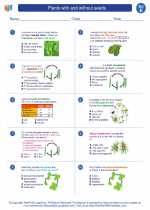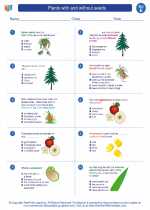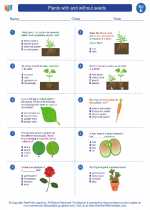Ferns
Ferns are non-flowering vascular plants that reproduce via spores. They belong to the group Pteridophytes and are found in various habitats such as forests, wetlands, and even deserts. Ferns have a unique life cycle and are known for their large, frond-like leaves called megaphylls.
Life Cycle of Ferns
The life cycle of ferns consists of two distinct stages: the sporophyte stage and the gametophyte stage.
Sporophyte Stage
- In the sporophyte stage, the fern plant produces spores in structures called sporangia, usually located on the underside of the fronds.
- When the spores are released and land in a suitable environment, they germinate and give rise to a small, heart-shaped structure called a prothallus.
- The prothallus is the gametophyte stage of the fern.
Gametophyte Stage
- The prothallus produces both male and female gametes.
- When water is present, the male gametes swim to the female gametes to fertilize them, forming a zygote.
- The zygote develops into a new sporophyte plant, completing the fern's life cycle.
Study Guide
Here are some key points to remember when studying ferns:
- Characteristics: Understand the unique characteristics of ferns, such as their frond-like leaves and spore reproduction.
- Life Cycle: Learn the two stages of the fern life cycle - sporophyte and gametophyte - and how they are interconnected.
- Habitats: Explore the different habitats where ferns can be found and how they adapt to their environments.
- Importance: Research the ecological and economic importance of ferns, including their role in soil conservation and as ornamental plants.
- Examples: Study specific examples of fern species and their unique features.
By understanding the life cycle and characteristics of ferns, you can gain a deeper appreciation for these fascinating plants and their role in the natural world.
.◂Science Worksheets and Study Guides Fifth Grade. Plants with and without seeds
Study Guide Plants with and without seeds
Plants with and without seeds  Worksheet/Answer key
Worksheet/Answer key Plants with and without seeds
Plants with and without seeds  Worksheet/Answer key
Worksheet/Answer key Plants with and without seeds
Plants with and without seeds  Worksheet/Answer key
Worksheet/Answer key Plants with and without seeds
Plants with and without seeds  Vocabulary/Answer key
Vocabulary/Answer key Plants with and without seeds
Plants with and without seeds  Vocabulary/Answer key
Vocabulary/Answer key Plants with and without seeds
Plants with and without seeds 

 Worksheet/Answer key
Worksheet/Answer key
 Worksheet/Answer key
Worksheet/Answer key
 Worksheet/Answer key
Worksheet/Answer key
 Vocabulary/Answer key
Vocabulary/Answer key
 Vocabulary/Answer key
Vocabulary/Answer key

The resources above cover the following skills:
Life Science
Obtain, evaluate, and communicate information to group organisms using scientific classification procedures.
Develop a model that illustrates how plants are sorted into groups (seed producers, non-seed producers) using data from multiple sources.